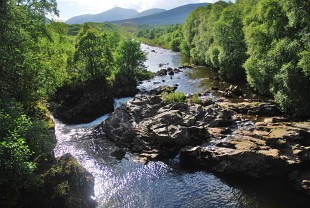
Cononish River near Tyndrum
The original planning application was refused by the Park Authority in August 2010. This latest application is an amended application which was submitted in July this year, it was given a cautious welcome by SNH and the John Muir Trust on the proviso that environmental concerns had been properly addressed.
Scotgold chief executive Chris Sangster told the BBC, “We are delighted with the recommendation in the report and are confident that, in considering its decision, the parks board will endorse the executive director’s recommendation.
“This would represent the culmination of three years’ detailed work towards planning a mining development which meets the exacting environmental standards required by the National Park Authority whilst providing a significant commercial opportunity in the interests of all stakeholders, in particular the local community which has been a keen supporter for a development that promises increased local employment and economic activity.”
Gordon Watson from the Park Authority said, “On balance, I have concluded that the temporary adverse impacts are outweighed by the anticipated outcome of a higher quality landscape and recreational experience being delivered in the long term. This benefit is in addition to the considerable economic benefits likely to accrue both to the Park area and wider Scottish economy. Critical to this is that the size, shape and contouring of the Tailings Management Facility can be restored to appear as a natural feature in the landscape.”
Full details of the report which will go before the Park Authority on 25 October as well as background papers can be found on the Park’s website.
The original application from Scotgold Resources Ltd was to mine gold and silver and develop a controversial water extraction system. The mine had previously been abandoned as uneconomic in 1997 but recent surges in world gold prices had fuelled interest and exploratory work by Scotgold. Scotgold Resources Ltd is reported to also be looking into potential mining activities at a site just outside the National Park boundary.
At the time of the original planning refusal the, then, convenor of the Park Authority, Mike Cantlay, who is now the boss at VisitScotland, said potential economic benefits could not be balanced against conservation concerns, but explained that the application had been a very difficult one to consider with compelling arguments on both sides. The original application had been described by Fiona Logan, chief executive of the Park Authority, as, “our Beauly-Denny in terms of controversy”.
Mr Cantlay told the BBC, “Our main concern lay with the design, scale and visual impact of the waste management facility which would hold 820,000 tonnes of slurry waste.
“At the end of the day, we could not balance the potential economic benefits against our primary aim to conserve and enhance our natural heritage, one of the original reasons for establishing National Parks in Scotland.”
At the time, the local community council for Tyndrum was in favour of the application, hoping that long term jobs would be created and tourism given a boost from the sale of Scottish gold products. However the Mountaineering Council of Scotland, the RSPB, Scottish Natural Heritage and the JMT all objected to the application on environmental grounds and some tourism businesses were worried that the damage to the enviroment would put off tourists attracted by the landscape and natural beauty of the area.
